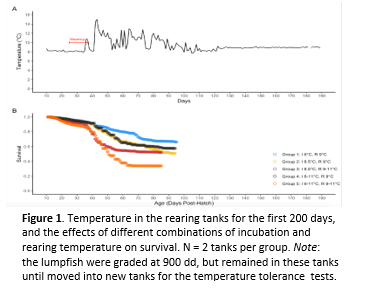THE THERMAL DEPENDENT BIOLOGY OF LUMPFISH: DIFFERENCES DUE TO TEMPERATURES DURING EARLY LIFE AND HOW TOLERANCE IS MEASURED
The use of lumpfish (Cyclopterus lumpus) as a “cleaner fish” in Atlantic salmon aquaculture has been very successful in mitigating the effects of sea lice on cage-site production. However, during the summer, there have been reports of lumpfish mortalities at some cage-sites in Atlantic Canada. Thus, we measured the upper thermal limits and metabolic physiology of lumpfish, with the goal of better understanding their physiology. Specifically, whether alterations in incubation or rearing temperature might improve their tolerance of high temperatures, and thus, welfare.
The specific egg incubation / larval & juvenile rearing temperature combinations were 6°C/9°C (standard production temperatures), 8.5°C/9°C, 6-11°C/9°C, 8.5°C/9-11°C and 6-11°C/9-11°C; with a range of temperatures indicating that the fish were exposed to stochastic temperature changes. Hatching success was lower in the stochastic-incubated group (~21%) as compared to the groups incubated under constant temperature (e.g., 6°C, ~61%), and larval survival in the 6-11°C/9-11°C group for the first 275 degree days (~89%) was lower than for all other groups (range 92.5 – 95%). As shown in Figure 1A, at this point, a temperature anomaly occurred and rearing temperature became variable and ranged from ~ 10 to 15°C for approx. 7 weeks., The fish incubated using standard industry protocols (6°C incubation / 9°C rearing) had the best survival during this period (~70%), whereas those exposed to stochastic incubation and rearing temperatures faired the worst (survival at the end of this period only ~30%). When the groups reached ~50 g critical thermal maximum (CTMax, at 2°C h-1) and incremental temperature maximum (ITMax, at 1°C per week) tests were performed on all groups. Not surprisingly, (given the temperature anomaly during rearing), there was no difference between groups for these metrics of thermal tolerance (mean values 22.9 + 0.1 °C and 20.6 + 0.02 °C, respectively) or in metabolic parameters measured during the CTMax test (values for standard and maximum metabolic rate, and aerobic scope, 34.5 + 1.6, 280.1 + 9.6 and 245.6 + 9.3 mg O2 kg h-1, respectively). Finally, we measured plasma cortisol levels in the fish used in the ITMax experiment at 10, 16, 18 and 20°C. Cortisol levels were 0.70 + 0.18 ng mL-1 at 10°C and 1.57 + 0.34 ng mL-1 at 16°C (P >0.05), but ~2.0 ng mL-1 at both 18 and 20°C (P < 0.05). These data suggest that lumpfish in sea-cages become stressed by 18°C. Further, they agree with the findings of other work in our lab. Specifically, while the CTMax and ITMax of lumpfish are approx. 3°C lower than for Atlantic salmon, temperature alone does not explain their losses at cage-sites during the summer months.
